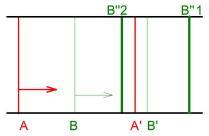
You are here: Building the Model: Advanced Elements > Material Handling Systems > Crane Systems > Moving Idle Cranes can Respond to Resource Requests
A crane can be idle and moving at the same time (moving to park or being pushed away by another). Independent of its current position and movement direction, the crane still has the capability to respond to resource requests coming from anywhere in the envelope. If allocated to a task with high enough travel-to-pickup move priority, the crane may reverse direction or terminate its move early, bumping other crane bridges on its way.
Whenever a crane bridge changes its claim, it checks to see if there are any bridges behind it that are going in the same direction with overlapping claims. If there are any, the newly claiming crane triggers a chain queue-up re-evaluation towards the following cranes. The following example demonstrates this case.

At time t0, crane A is called for a task and starts moving to [A'] with move priority mpA, pushing idle bridge B to [B' = A' + bridge separation]. At time t1 (bridge A and B are still moving), a request for crane B comes from [B" (1 or 2)] with move priority mpB. Bridge B is allocated to the task immediately since it is available at the time.
If the new destination of bridge B is [B"1], the new claim of bridge B does not conflict with the existing claim of bridge A, so the move priorities are not significant. ProModel re-evaluates all motion values for crane B (acceleration, deceleration, empty and full speeds for both the hoist and the bridge) and crane B starts moving to its new destination. If the bridge motion expressions for crane B have changed their values between t0 and t1, the queue-up status between bridges B and A (and any others behind A) may change, so ProModel performs a chain queue-up re-evaluation.
If the new destination of bridge B is [B"2], the new claim of bridge B conflicts with the existing claim of bridge A, so ProModel considers the move priorities:
• If mpB <= mpA, then B does not have enough priority to stop A before A gets to its destination. Bridge B will have to go on moving until [B'] and wait until it can claim the region [B"2 ~ B'] in the Ć direction.
• If mpB > mpA, then B does have overriding priority over A. Bridge B stops bridge A at [B"2 - bridge separation], starting a chain move termination which tells bridge A to stop any other followers with the appropriate bridge separation distances between each. In this case, bridge A (and other possible followers) will have to wait until the next reclaim trigger event to attempt reaching their original destinations.